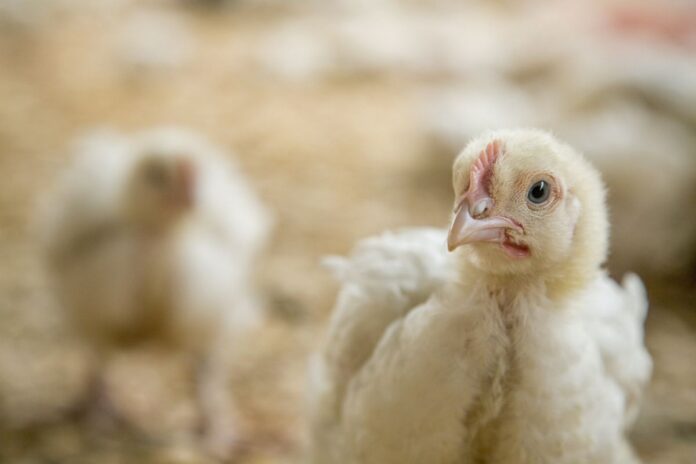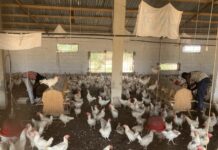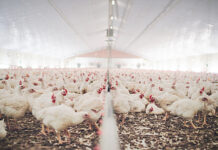
The Brazil poultry sector shows good dynamics this year, thanks to the ever growing domestic production and exports.
Historically poultry farming has been considered one of the main drivers of the Brazil national agribusiness, playing a crucial role in the country’s economy. In fact, the development of poultry farming in Brazil began with the Portuguese colonizers who introduced poultry farming during the colonial period. Since then, the demand for chicken meat has been growing.
At present Brazil is the second largest global producer, which produced around 15 million tons of poultry meat in 2023, a historic record for the country. In terms of the number of poultry slaughtered, there were more than 1.5 billion, with the South region contributing almost 60% of the overall output. The main producers are Paraná (34%), Santa Catarina (13%) and Rio Grande do Sul (12%).
Since 2013, the Brazil poultry production has increased its output by about 2.5 million tons up to 15 million tonnes. This year the growth is ongoing, despite the ever rising production costs and the ongoing geopolitical uncertainty, caused by Russian-Ukranian war. As for production costs, in recent years there has been a significant increase of prices for corn and soybeans both in the Brazil and global markets. However, the increase in productivity in the poultry sector in Brazil in recent years has generated savings in time and quantity of feed for animal weight gain.
In the past, it took 105 days for a chicken to reach slaughter weight, and 3.5 kg of feed was needed to gain 1 kg of weight. Currently, the growth cycle is 40 days (a reduction of 62%) and the ratio is 1.6 kg of feed consumed for 1 kg of weight gain (a 55% increase).
According to Renato Klu, a country manager of Quimtia Brasil, one of the Brazil’s major agricultural holdings, the outlook for the current year is approximately 16 million tons, which is by about 17% higher than in 2023.
Renato Klu comments: “The first six months of the year have already been marked by impressive numbers and a performance above expectations. But with the end of the year approaching, the trend is that Q4 of the current year will be quite positive for chicken meat consumption, hence high expectations for the production chain”.
In the meantime, exports also show good growth rates this year (up to 7%-8%, compared to 2023). In 2023 exports grew by 6,6%, exceeding 5 million tonnes being equivalent to about US$10 billion in value terms. In general, Brazil exports about 35% of its overall output to more than 150 countries, contributing 38% of total international trade. For comparison, the value of exports is greater than the entire chicken meat production of Russia, which is the 5th largest global producer of chicken meat.
In accordance with the recent report of the Brazil Canal Rural TV channel, currently, China, the United Arab Emirates and Japan continue to be the largest importers of Brazilian chicken meat. The Brazil government, together with local producers, are constantly working on the opening of new markets for the domestic poultry along with expansion of presence on existing ones. For the current year several Brazil poultry factories received permissions for the beginning of exports to China, Israel and the number of other countries.
According to Luis Rua, director of markets from ABPA, “there are good prospects for increased exports from the opening of new markets and expansion in already existing destinations, which is also due to the slowdown in shipments from important competitors, such as the European Union and Canada. On the other hand, the consumption of poultry meat in the domestic market is also growing, which may contribute to re-direction of supplies from export to domestic markets”.
According to predictions of USDA. Brazil will remain the biggest global poultry supplier, which overall exports reach about 6,8 million tonnes annually with almost 41% of the market share.
In recent years, the Brazil government has begun to pay more attention to health issues in its poultry farming, given the ever growing spread of avian influenza, which have required significant investments in biosecurity and epidemiological surveillance to ensure the health and food safety of birds. Probably the most complex situation with influenza was observed on the coast of Paraná, the center of poultry meat production in Brazil.
Still, according to earlier statements, made by Ricardo Santin, President of the Brazilian Animal Protein Association (ABPA), despite the circulation of the virus in the country and Parana state for over 200 days, fortunately it has not had a major negative impact on the Brazilian poultry farming.
Ricardo Santin comments: “This is a record, and it sets us apart from the rest of the world. While many countries are dealing with influenza in animal and poultry production, Brazil continues to maintain its high biosecurity, its valuable health status. Our biosecurity is working”.
According to data from the Brazilian Animal Protein Association, there are 3.5 million direct and indirect jobs across the production chain, while local poultry factories employ more than 300,000 workers. Per capita consumption of this protein is significant, with each Brazilian consuming an average of 45 kilos of it per year, a rate that has been maintained since 2020. Also according to ABPA, the average per capita consumption was 10 kg in 1986, which means that the increase was more than 350% in 36 years. Currently chicken meat is the most consumed meat types in Brazil although, according to some local analysts, a further growth of consumption may be prevented by the generally high rate of inflation.
Ricardo Santin, ABPA’s president comments: “Our production chain is continental in scope and plays a decisive role in the habits, economy and gastronomic culture from North to South. From the fields to the factories, billions are invested in cutting-edge technology to ensure the quality and health of products, with greater productivity. It is one of the country’s food foundations and an economic pillar for several regions”.
Egg production should also increase
In case of eggs’, according to analysts’ predictions, the per capita consumption is expected to reach close to 300 this year, reaching the same level achieved during the pandemic. However, even though a large part of egg production is destined for domestic consumption, egg exports from Brazil demonstrated positive dynamics last year as grew by 175% up to 26,000 tonnes. In terms of production, last year egg production in Brazil amounted to 52.55 billion units an increase of up to 1% compared to 2022. This year the growth is ongoing.

















